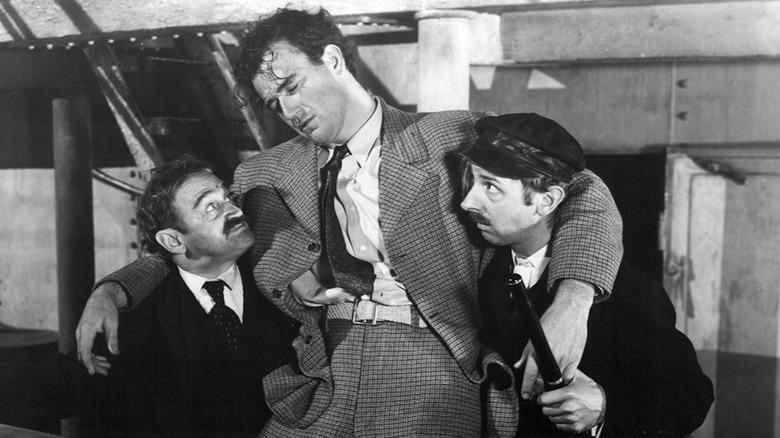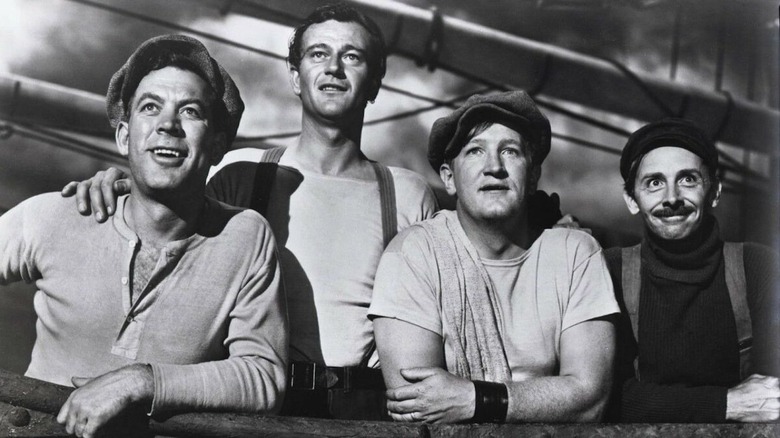The Long Voyage Home Was A Gamble That Could Have Sent John Wayne Back To B-Movies
John Wayne had finally broken free of Poverty Row B-flicks as the lead of John Ford's classic Western "Stagecoach" when he jockeyed for the lead in the filmmaker's 1940 seafaring drama "The Long Voyage Home." Like "Stagecoach," this World War II-set yarn about a tramp steamer wending its way from the West Indies to Baltimore and then on to England is an ensemble work. It is also one of Ford's most formally considered features, bolstered by expressive cinematography from the great Gregg Toland (who was one year away from changing the filmmaking game forever alongside Orson Welles with "Citizen Kane").
Wayne had made his name on Westerns, and with World War II on the horizon — which would take some of his stiffest movie star competition, most notably James Stewart and Henry Fonda, out of the country for four years — he had an opportunity to become one of the biggest names in the industry. Wisely, he kept busy, booking one Western after another with Republic Pictures. But he was keen to stay in Ford's good graces, and sought the part of Swedish seaman Ole Olsen in "The Long Voyage Home." The director, who famously joked about his star's lack of acting ability, surprisingly capitulated. Wayne was to play a provincial Scandinavian with a Swedish accent.
How did this work out for the newly minted star?
The less John Wayne acts, the better
Wayne was a tad shocked that Ford gave him the role, but it made basic box office sense. The Duke had connected with rank-and-file moviegoers, so his name and image on the poster might drive folks to take a chance on a moody drama based on a series of one-act plays by Eugene O'Neill.
But if Wayne was hoping for more nuanced direction from Ford than he'd received in the past, he was completely out of luck. According to Randy Roberts and David Welky's "John Wayne: Treasures," the star was understandably worried about not so much nailing his Swedish accent, but getting across a semi-reasonable facsimile. Put in modern-day terms, he didn't want to come off like Kevin Costner in "Robin Hood: Prince of Thieves." Other directors might've been more attentive to their star's concerns, but the brusque Ford shrugged off Wayne's request. "Well, Jesus, all right, if you want to be a goddamn actor," he said.
"The Long Voyage Home" was a commercial dud and a critical success. Academy voters were impressed enough to give it six Oscar nominations, most of which emphasized the film's technical mastery. As for Wayne's performance, it's endearingly meek. Ole's iffy command of English allows Ford to cut way back on the star's dialogue, which forces Wayne to give a physical performance. His apprehensiveness, encouraged by Ford (to the actor's chagrin), leaves the Duke looking like a bit of a sap (à la his brief appearance as Barbara Stanwyck's prey in Alfred E. Green's "Baby Face"). When asked about the portrayal, Ford said, "Count the times Wayne talks ... That's the answer. Don't let him talk unless you have something that needs to be said."
Over the next few years, Wayne would learn how to protect his image. He became a brilliant modulator. He could make small adjustments, but he would never, ever make a departure. People wanted John Wayne, and he was obliged to give this to them.

